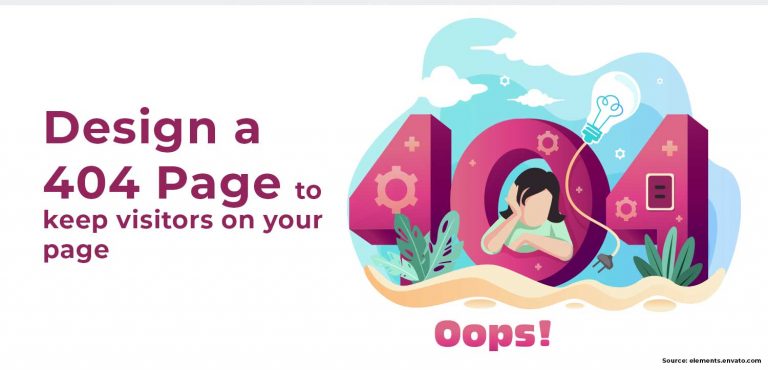It would be nice if you could make a website that always worked perfectly and never had any broken links, but unfortunately, just like taxes and bad hair days, broken links are inevitable. The trick to building a better business website is to turn this unpleasant situation into an amazing opportunity to charm your visitors.
Table of Contents
What’s a 404 page?
A 404 page is a webpage that lets your visitors know that a page they’ve tried to look for doesn’t exist at that URL. In other words, it’s a webpage that displays the HTTP 404 error message, which is also called the “Page Not Found”, “Server Not Found”, or “404 Not Found” error message. When a visitor gets this error, that means their browser communicated with your website, but the browser couldn’t find the page they were looking for.
This is frustrating, but there’s actually a secret to creating a 404 page that makes your visitors feel happy, instead of irritated:
Get inspired
If you want to make a website 404 page that your visitors will like, the most important thing to do is to take a note of 404 pages that you like. We’ve all stumbled across a 404 page at one time or another. Were there any that managed to make you smile? What did you like about it?
Without copying the 404 page of another website, see if you can create a website 404 page that has the same spirit.
Can you have a good 404 page and build a website fast?
These days, it’s almost impossible for a business to survive without a website, so it’s very likely that you’ll want to build a website fast. This would be prudent. You can always add things to your website later, but instead of waiting for years polishing your content until it’s perfect, it really is better to try to build a website fast.
But here’s the thing:
Just because you build a website fast doesn’t mean you need to end up sacrificing quality for speed. If you use a great website builder, you can build a website fast and have a simple, clean template that your visitors will love. This means your 404 page will be easy to read, and your visitors won’t have to waste time squinting at the page, trying to figure out what your website is trying to tell them.
How to make a website branding opportunity out of a 404 page
And now for the tips on how to turn the dreaded 404 page into one of the tools in your brand promotion strategy:
1. Talk like a person, not like a robot
When you make a website 404 page, it’s tempting to distance your website from the error by drowning your visitors in technical jargon in the hopes that they’ll be too confused to realize that something just went wrong.
But, when you use lots of technical language, you irritate your visitors even more. (Now they’re angry and confused!) Your visitors are more likely to stick around when you use emotional language, instead. That’s why so many 404 pages start with phrases like “Oops” or “Uh-oh”. Once you’ve pacified your visitors a bit, then you can start explaining what happened.
2. Tell your visitors what might have gone wrong
Explain to your visitors might have gone wrong. You might think it’s enough to say “404 error”, but some people don’t know what this means.
They might think that the 404 page means that your website is broken or that you’ve somehow given their computer a virus. To help put them at ease, briefly explain what might have happened to cause the 404 error.
And be especially sure to follow step 3, to stop them from feeling trapped:
3. Show your visitor where to go next
The most important part of your 404 page (after the part where you tell them what happened, of course), is the part where you show your visitors how to leave the page without leaving your website.
Give them links to your homepage, or links to other webpages they might be interested in, and give them a search bar that they can use to look for the content they wanted in the first place.
When you do this, you give them a way to leave the error message while staying on your website.
4. Add brand-friendly pictures
When you create a website 404 page, one of the best ways to keep your visitors happy is to keep the page from being too grim. You don’t want to create a website error page that sends the message that the 404 page is the worst thing that could possibly have happened on your website. Add a few brand-friendly pictures to communicate the idea that broken links are nothing to worry about.
5. Don’t overload the page
In your efforts to make an error page that tells your visitors what happened, make sure you don’t create a website 404 page that makes them feel overwhelmed. Keep your page design as simple as you can.
Don’t use alarming stylized text that zips across the page or add lots of images or write a long epistle in which you explain to your visitors how deeply sorry you are that they’ve seen your 404 page.
Keep your page design simple.
6. Lighten up!
It’s one thing to add a few words showing that you’re sorry. (After all, you don’t want your visitors to think you don’t care about them.) But there’s a fine line between being repentant and groveling. Remember: This happens to all websites at some time or the other.
And sometimes, it might not even be your fault! Sometimes, visitors reach a 404 page because they typed the URL incorrectly.
So, don’t go penning a personal letter of apology to each of your visitors just yet. As long as you don’t make light of your visitors’ frustration to the point where you chase them away, you don’t need to be somber about it, either.
A little humor will go a long way on your 404 page.
7. Stay on top of your site maintenance
Try to minimize the number of 404 pages that your visitors see on your website. When you make a website, make every effort to ensure that all your links are fully functional. Perform regular site maintenance to make sure your visitors generally have a smooth experience when they visit your website.
And if they do reach a 404 page, make sure it helps solidify your brand!
The wrap-up
Broken links happen. You can treat your 404 page like something you’re ashamed of, or you can proudly incorporate it into your brand in a way that makes your visitors love your website even more! When you follow our seven tips, you won’t need to worry about losing your visitors when they stumble across your 404 page.






